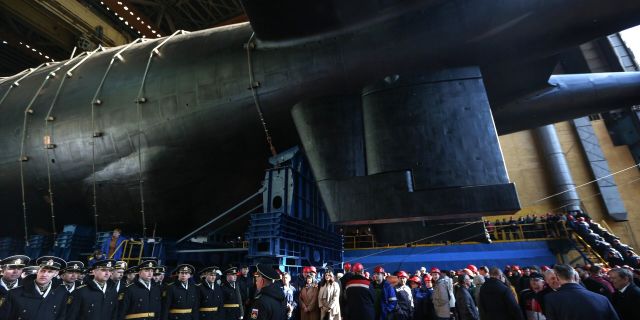Belgorod: a giant submarine for nuclear war
The giant Belgorod submarine is designed to launch the Poseidon underwater drone with a nuclear charge and can serve as a base for spy platforms operating underwater, Asia Times writes. In addition, it can become the location of the Losharik submarine.
Gabriel Honrada
On July 8, the Russian Navy received the K-329 Belgorod, the longest nuclear submarine in the world, the Sevmash plant said in a statement.
Although the exact characteristics of the Belgorod are not published, the Naval News website suggested that the Belgorod (project 949A "Antey", according to the NATO codification – Oscar II) with its enlarged hull 178 meters long and 15 meters wide is inferior in size only to the only boat in service of the project 941 "Shark" (according to the NATO codification – SSBN Typhoon).
Naval News also notes that Belgorod probably exceeds its predecessors in displacement (19,000 tons) – this is more than the largest western submarine of the Ohio class ("Ohio").
According to Sevmash, Belgorod is designed to solve scientific problems and conduct search and rescue operations. In addition, it can carry deep-sea rescue vehicles and autonomous underwater drones.
According to Naval News, Belgorod will become the world's first carrier of an underwater drone with nuclear weapons Poseidon, whose nuclear strike on settlements, large cities and industrial centers near the coast can cause a devastating radioactive tsunami.
The Warzone reports that in addition to the Poseidon drone, Belgorod can serve as a base for a number of unmanned spy platforms, as well as for Losharik.
The source notes the reinforced lower rudders of the Belgorod, which will allow it to lie on the seabed, as well as the ability to launch drones to listen or cut underwater communication cables.
This can "blind" the enemy and cause serious damage to him, since 95% of the world's Internet traffic goes through underwater cables, the analytical center of the Atlantic Council notes.
Russian military analyst Alexei Leonkov explained the likely role of Belgorod as follows: in his opinion, it is designed to launch the Poseidon drone and will specialize in retaliatory strikes. Leonkov called Belgorod a "weapon of retaliation": in the event of a large-scale nuclear war, Russia will launch Poseidon drones in response to the first strike using mobile missiles, ground-based launchers and intercontinental ballistic missiles based on land and sea.
He notes that Poseidon can be used not only for a retaliatory strike, but also against aircraft carrier groups, and Belgorod will deliver it to the launch site.
However, questions remain about Poseidon. In an article in the Military Review, Roman Skomorokhov noted that the United States has three versions on this score.
First, the United States may consider Poseidon a propaganda trick. He admits that despite all the hype among the US military, it may just be a mock–up - a distraction to intimidate the American public and military planners.
Secondly, the United States may conclude that Poseidon is a research vehicle rather than a drone with nuclear weapons, as Russia claims. And, finally, thirdly, the United States may decide that Poseidon is a real weapon and begin to develop appropriate means of protection.
At the moment, strategic uncertainty seems to be Poseidon's main trump card. Skomorokhov admits that there is logic in creating such a formidable weapon as Poseidon, but notes that the reliability of its existence and capabilities is difficult to verify.
At the same time, he admits that Poseidon can really be a Doomsday weapon, or at least create such an appearance in order to prevent an attack on Russia in the first place. Be that as it may, he notes, the conflicting data has probably already confused American military planners.
According to The Barents Observer, Belgorod will begin trial operation in the Northern Fleet, and then it will be transferred to the Pacific Fleet. However, it is not disclosed where exactly Belgorod will be based during operation in the Northern Fleet.
The publication offers two possible locations: Severodvinsk, where the Poseidon drone is being developed, or Olenya Guba on the Kola Peninsula, where other Russian special-purpose submarines are based.
According to the US military database ODIN, Poseidon is not a single type of device, but a whole family of underwater drones. Some devices can attack coastal targets, while others are designed as supercavitating torpedoes to sink carrier battle groups. The nuclear variant is armed with a cobalt warhead with a capacity of 2 megatons, which can infect an area of 1,700 by 300 kilometers – that is, it is a weapon of last resort.
The same source claims that Poseidon is a robotic submarine with a diameter of 1.6 – 2 meters and a length of 24 meters. Its maximum speed is 100 km/ h, the range is 10,000 kilometers, and the maximum diving depth is 1,000 meters. At the same time, the drone can operate at a depth of 50-100 meters in low-speed mode to increase stealth.
It is reported that in low-speed mode, it can approach the target for several weeks, after which it will switch to high-speed mode at the last 2-3 kilometers.
According to the GlobalSecurity website, the Losharik is a non–armament-carrying saboteur submarine. It can dive to a depth of up to 6,000 meters and is considered the quietest and noiseless submarine of the Russian fleet.
It is designed for laying depth charges in hard-to-reach places, for surveillance and surveillance, listening and destroying underwater cables. In addition to these tasks, she can explore the seabed, raise the remnants of secret equipment from the bottom and conduct special operations.
Since Losharik is a highly classified project, its specific dimensions are unknown. Its approximate length is estimated at 69-79 meters, width – seven, and estimated displacement – 2000 tons. The Losharik is equipped with a nuclear power plant, develops a maximum speed of 55 km / h and accommodates a crew of 25 people.

